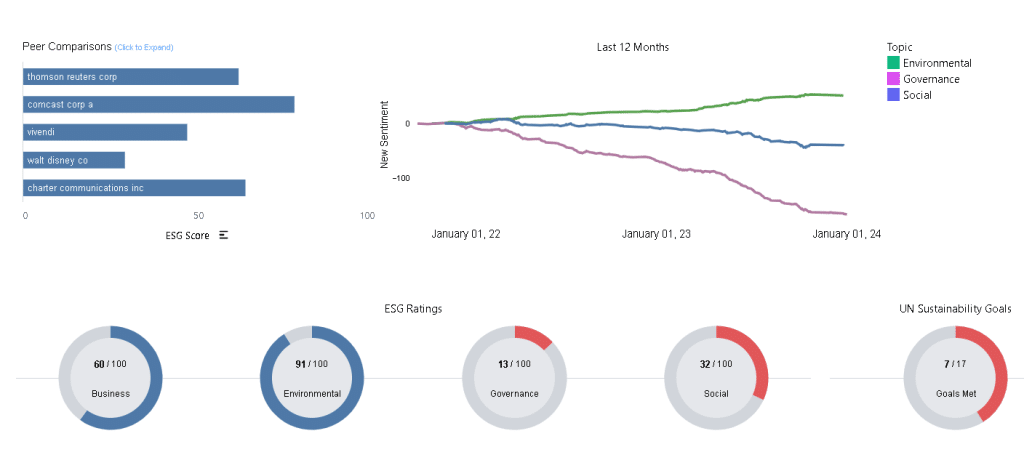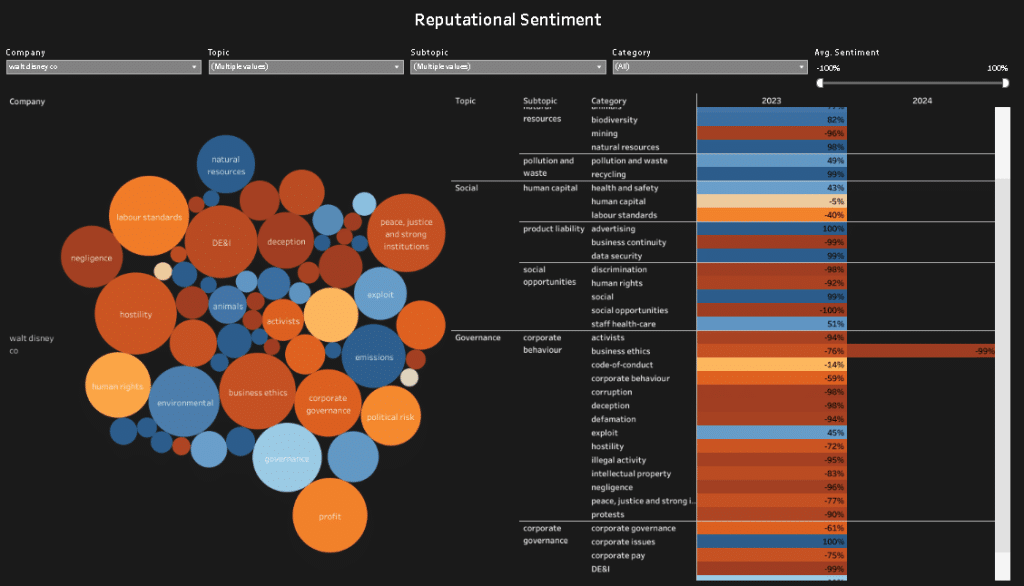Step into the magical world of Disney, where dreams come true and fairy tales unfold on the big screen. But have you ever wondered what lies beyond the enchanting stories and captivating characters? In recent years, Disney has been the subject of increasing scrutiny with regards to their ethical practices. In this article, we’ll take a closer look at our Disney ESG score, based on our AI-driven news sentiment analysis.
Understanding ESG Scores and their importance
Before we dive into our Disney ESG score, let’s first understand what ESG scores are and why they are important. ESG scores are a measure of a company’s environmental, social, and governance practices. They evaluate how well a company performs in areas such as carbon emissions, waste management, labor practices, diversity, board composition, and ethical conduct. ESG scores have gained prominence in recent years as investors and stakeholders increasingly recognize the importance of sustainability and responsible business practices.
ESG scores provide investors with valuable insights into a company’s sustainability performance, allowing them to make informed decisions about where to invest their money. These scores also serve as a benchmark for companies, encouraging them to improve their practices and align with global sustainability goals. By measuring a company’s environmental and social impact, ESG scores hold them accountable for their actions and drive positive change in the corporate world.
Disney ESG score: Environmental factors
One area where Disney performs very well within ESG indicators is within environmental factors. Disney has long been committed to environmental sustainability, recognizing the importance of protecting the planet for future generations. The company has set ambitious goals to reduce its environmental footprint and has made significant progress in achieving them. One of Disney’s key initiatives is its commitment to achieve net-zero greenhouse gas emissions by 2050. To accomplish this, Disney has implemented various measures to reduce its carbon emissions, such as investing in renewable energy sources, improving energy efficiency in its operations, and promoting sustainable transportation.
In addition to reducing its carbon footprint, Disney is also focused on conserving water resources. The company has implemented water conservation programs across its theme parks, resorts, and cruise ships, aiming to minimize water consumption and promote responsible water use. Through innovative technologies and responsible practices, Disney has managed to reduce its overall water consumption and contribute to the preservation of this precious resource.
Disney is also actively working towards reducing waste and promoting recycling. The company has implemented waste management programs that prioritize recycling and waste diversion. By partnering with local communities and organizations, Disney ensures that its waste is properly managed, reducing the impact on the environment and promoting a circular economy.
Disney’s commitment to environmental sustainability extends beyond its own operations. The company actively engages in conservation efforts and supports environmental initiatives globally. Through collaborations with non-profit organizations, Disney contributes to the protection of wildlife and habitats, raising awareness about the importance of biodiversity and conservation.
Disney’s dedication to environmental sustainability is not only reflected in its practices but also in its storytelling. Many of Disney’s films and characters promote environmental awareness and inspire audiences to take action. By weaving sustainability themes into its stories, Disney educates and empowers millions of people around the world to make a positive impact on the planet.
Challenges and criticisms of Disney’s sustainability efforts
Despite Disney’s strong commitment to sustainability, the company has faced challenges and criticisms regarding its environmental and social impact. One of the main criticisms leveled against Disney is its contribution to waste and pollution through its merchandise and packaging. Critics argue that the production and disposal of Disney-themed products generate significant waste and contribute to plastic pollution. While Disney has taken steps to address this issue by promoting recycling and responsible packaging, there is still room for improvement.
Another area of criticism is Disney’s reliance on fossil fuels for its operations and transportation. While the company has made progress in reducing its carbon emissions, some argue that Disney should accelerate its transition to renewable energy sources and explore more sustainable transportation options.
In terms of social responsibility, Disney has also faced criticism for its labor practices, particularly in relation to its theme parks and resorts. Critics argue that the company should do more to ensure fair wages and working conditions for its employees, as well as address issues of diversity and inclusion within its workforce.
It is important to recognize these challenges and criticisms as opportunities for Disney to further improve its sustainability efforts. By addressing these areas of concern, Disney can strengthen its ESG score and continue to lead by example in the entertainment industry.
Disney ESG score: Social factors
Here is where the news is not so good. Our Disney ESG score shows a lot of room for improvement. In comparison to its environmental score, their social score is low and can be attributed to various factors, primarily revolving around worker conditions and the disparities between the company’s public image and its practices behind the scenes.
Disney has faced criticism and negative attention for its history of worker abuse across the globe, significantly impacting its social score. Reports from human rights groups since the late 1990s have highlighted that many of Disney’s consumer products were made in sweatshops in countries like Bangladesh, China, and Haiti, where workers were subjected to deplorable conditions, including being paid below the minimum wage, forced to work excessive hours without proper compensation, and facing verbal and physical abuse.
More recently, Disney workers have taken issue with being grossly underpaid, and Disney employees were among those involved in a human trafficking sting in 2022. The darker side of Disney is often reported on, more recently coming under fire for sexualizing children.
Further exacerbating the issue, investigations have consistently uncovered labour violations in factories producing Disney-branded goods. These include the hiring of underage workers, unsafe working conditions, sexual harassment, destitution-level wages, and exposure to toxic chemicals. Disney has claimed it has no legal responsibility for these conditions as it does not own the factories but uses subcontractors. However, its monitoring systems have failed to uncover or address these inhumane conditions that independent human rights groups have exposed.
In the United States, particularly at Disneyland and Disney World, employees have reported being paid wages so low that they face homelessness, food insecurity, and inability to afford basic expenses and healthcare. Despite the immense revenue generated by Disney’s parks and products, the prosperity has not trickled down to its workers, contributing to a significant disparity between the company’s executive compensation and the financial struggles of its frontline employees. This situation has led to public outcry, advocacy from political figures like Senator Bernie Sanders, and initiatives to improve wages and working conditions for Disney’s employees.
Disney’s social score suffers due to these reported discrepancies between its brand image as a purveyor of happiness and magic and the harsh realities faced by many of its workers worldwide. This reflects broader concerns within society about corporate responsibility, the ethical treatment of workers, and the role of large corporations in addressing social and economic inequalities.
Disney ESG score: Governance factors
Disney’s governance score is low, reflecting areas needing improvement across several domains, particularly in executive compensation and shareholder rights. For instance, the company’s CEO compensation is significantly higher than the median for large-cap corporations, and there are concerns about the lack of specific, quantifiable performance targets for top executives. Additionally, provisions unfriendly to shareholders, such as the high threshold for calling special meetings and supermajority vote requirements for certain approvals, contribute to the lower governance score.
Disney has been in the news recently for concerns regarding its corporate governance practices recently, with several specific issues driving the discussions:
1. Handling of the “Don’t Say Gay” bill
The company’s initial silence on the Florida bill that restricts discussions on LGBTQ+ topics in schools drew criticism for not taking a stand against what many perceive as discriminatory legislation. This initial response was followed by internal pressure and public backlash, leading Disney to eventually come out against the bill. However, the perceived slow and reactive nature of their stance fueled negative discussions questioning their leadership’s judgment and responsiveness.
Executive compensation
The high compensation packages for executives, particularly CEO Bob Chapek, continue to be a point of contention. Critics argue that these packages are excessive compared to the average employee’s pay and may not be adequately tied to company performance. This raises concerns about income inequality and the board’s responsibility in setting fair compensation structures.
Board composition and independence
Questions have been raised about the composition of Disney’s board and its ability to provide effective oversight due to perceived lack of diversity in backgrounds and potential conflicts of interest. Some argue that a board with broader perspectives could improve decision-making and accountability.
Scarlett Johansson lawsuit
While not directly related to traditional corporate governance practices, the lawsuit highlights potential tension between shareholder interests and talent relationships. The lawsuit argues that prioritizing streaming releases over theatrical releases negatively impacted the actress’s compensation, sparking questions about equitable treatment of contributors and long-term talent management strategies.


Disney ESG score: Final thoughts
Our journey through Disney’s ESG scores reveals a complex picture, where commendable environmental initiatives are juxtaposed with significant challenges in social practices and governance.
Disney’s commitment to environmental sustainability, through ambitious carbon neutrality goals, water conservation efforts, and waste management programs, demonstrates a proactive approach to addressing global environmental issues. These efforts reflect Disney’s understanding of its responsibility towards the planet and future generations, making strides in embedding sustainability into its operations and storytelling. However, the environmental accolades contrast sharply with the social and governance aspects of its operations.
The social score paints a grim picture of the disparities between Disney’s magical facade and the reality of its workers’ conditions. The historical and ongoing criticisms concerning labour practices, including underpayment, poor working conditions, and a lack of fundamental rights, highlight significant areas for improvement. These issues not only affect Disney’s reputation but also underscore the critical need for more ethical treatment of workers globally. The governance score further reveals concerns around executive compensation and shareholder rights, pointing towards a need for more transparent, equitable, and accountable corporate governance practices.
As Disney continues to enchant millions around the world, it is imperative that it also leads by example in ethical practices. Addressing the criticisms and challenges head-on can strengthen Disney’s ESG score, ensuring that the company not only delivers on dreams and stories but also on a commitment to sustainability, equity, and responsible governance. The journey towards improving these scores is not merely a regulatory requirement but a moral imperative, reflecting the evolving expectations of investors, stakeholders, and the wider community.
In essence, the Disney ESG score analysis demonstrates an opportunity to harmonise its reputation as one of the greatest storytellers of all time with robust ethical practices, ensuring that the magic of Disney extends beyond the screen into real-world positive impacts. As Disney looks to the future, embracing these challenges and opportunities can further solidify its position as a leader not only in entertainment but in corporate responsibility and ethical leadership.
Find out more
Looking for detailed and granular ESG data on Disney? At Permutable AI, we specialise in providing comprehensive ESG insights to help corporates make informed decisions. If you require in-depth analysis on Disney or other companies in the entertainment sector, we invite you to get in touch.
